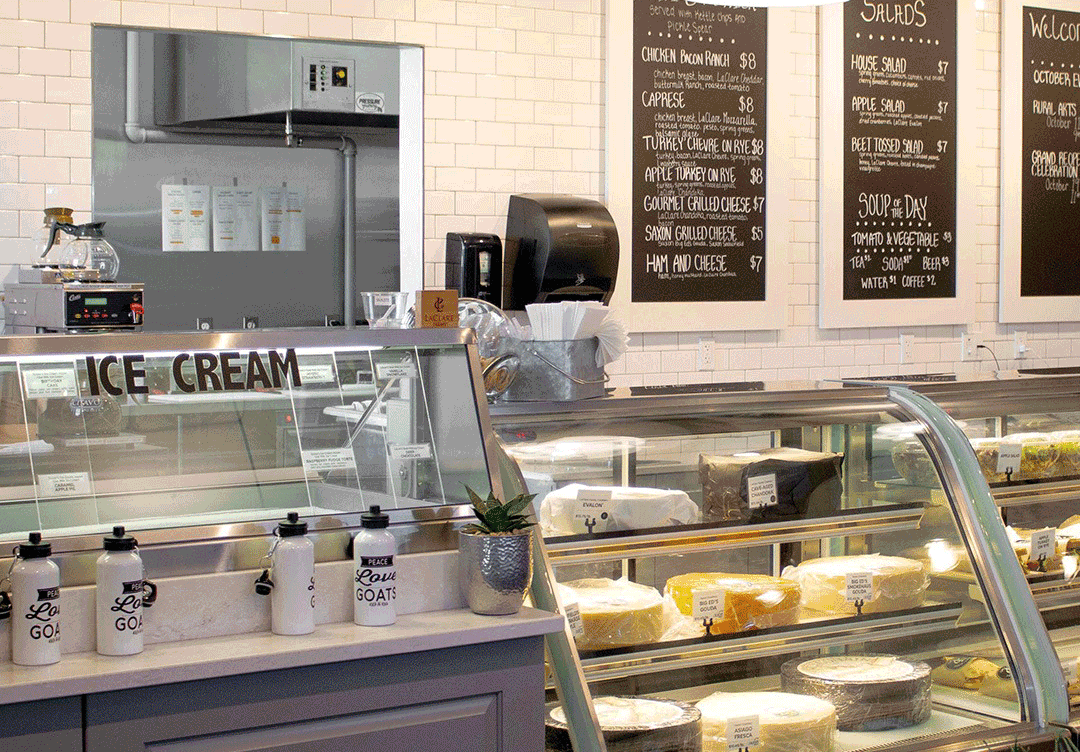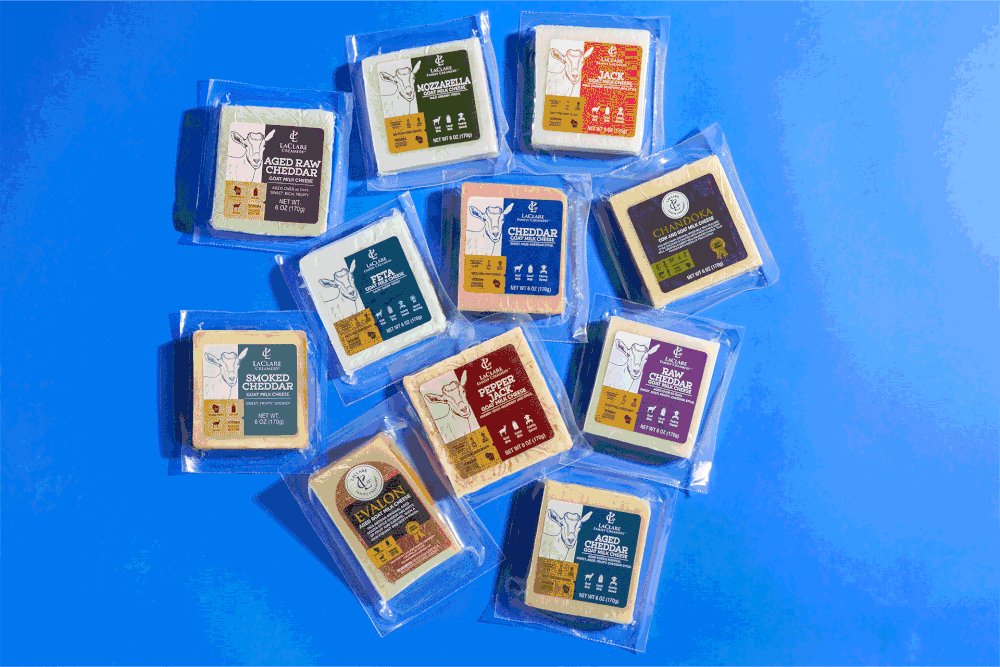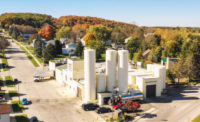Wisconsin’s reputation as “America’s Dairyland” remains a point of pride in a state where cows not only serve as the lead brand ambassadors but the primary engines of the economy. However, in rural Malone, Wis., LaClare Creamery LLC continues to expand, challenge, and revitalize the state’s definition of “dairy” by emerging as a major force in the surging goat cheese category.
LaClare uses the freshest, premium milk to create its own unique canvas: chèvre, which means “goat” in French and is bright, tart, and tangy in taste with a slightly crumbly texture.
President of LaClare Creamery since 2022, Alex Coenen explains the creamery first started off producing small batch artisan hard cheese in the late 2000s, but it wasn’t until 2012 when it stopped renting space and began calling Malone, home.
“We continued to grow in popularity, and we had more and more needs, so in 2017 we purchased some chèvre-making equipment from Heartland Creamery in Missouri and that really kicked off our growth into the chèvre category,” Coenen tells Dairy Foods during a tour of its 17-acre facility. “We're sitting up in the observation booth of the chèvre plant, which was a new addition we completed in 2019. The existing site makes our hard cheeses, and the 41,000-square-foot plant we’re sitting on top of does our award-winning chèvre.
“Right in our backyard, we have the highest concentration of dairy goat farming in the nation,” he continues. “Our cheese has a fresh, clean, awesome taste that consumers love. What’s unique about us is that we’re distributed in all 50 states and our brand is 100% made from Wisconsin milk.”

“Right in our backyard, we have the highest concentration of dairy goat farming in the nation. Our cheese has a fresh, clean, awesome taste that consumers love. What’s unique about us is that we’re distributed in all 50 states and our brand is 100% made from Wisconsin milk.”
— Alex Coenen, president, LaClare Creamery
Located 170 miles north of Chicago and 11 miles northeast of Fond du Lac, Wis., LaClare Creamery boasts a Visitor Center, Cheese Shoppe, Café, Garden Center, and Goat Farm where the family-friendly destination at W2994 County Road HH — and goat greeters Milo and Shiloh — annually welcomes 130,000 visitors for a “bleating” good time at a wide variety of events. This includes its first Goatoberfest (Sept. 29, 2023), which encompassed an inaugural kid’s fun run/walk through the goat barn, kiddie pedal pulls, fall décor, free games and activities, a pig roast, live entertainment on the East Patio, Oktoberfest brews and the chance for visitors to get an inside look at the farm-to-plate cheesemaking process.
And because who doesn’t love the thought of exercising or snuggling with baby goats, other family-fun activities hosted throughout the year include do-it-yourself cheese board making, crafts, goat yoga classes, cheesemaking classes, goat petting, easy appetizer classes with retail manager Jessi Schoofs and to beat the winter doldrums, there’s the popular Baby Goat Snuggles and Pajama Party event.
“Our various events help families get up close with our goats and gain a better understanding of how valuable our goats are in producing fresh milk for all our farm-fresh cheese,” notes LaClare Creamery Marketing Specialist, Nola Krueger. “Around holidays, like the Super Bowl, we offer premade Big Game Party Platters that contain an assortment of our products along with two new exclusive cheese sauces made inhouse by our chef.”

The LaClare Creamery Café menu features such items as Blueberry Vanilla French Toast topped with the creamery’s Blueberry Vanilla Goat Cheese, a Caprese salad with LaClare’s Goat Mozzarella, and a Chicken Bacon Ranch sandwich with LaClare’s Goat Cheddar. There’s also goat and cow milk ice cream available for dessert.
The company’s website (laclarefamilycreamery.com) features recipes for some delectable desserts like Mixed Berry LaClare Goat Cheese Cheesecake that is made with the creamery’s award-winning Original Goat Cheese — Coenen’s personal favorite because of its “tasteful simplicity and the fact that there’s nothing to hide behind. It highlights the commitment we have to our farms, animals, and milk that we try so hard to take care of.”
Setting a high standard with fresh, clean goat milk
Today, LaClare produces 60 SKUs of soft, hard, and aged cheeses made with goat milk, mixed milk (a combination of goat and cow milk), and chèvre soft goat cheese. Among the more than 60 awards earned since the creamery began producing cheese onsite in 2012 are Evalon, a goat milk Gouda-style cheese honored nine times at cheese contests, notching First Place, Best of Class at the 2018 World Dairy Expo Championship; Cave Aged Chandoka, a mixed milk Cheddar-style cheese that was named Best of Class at the 2022 World Championship Cheese Contest and is aged 9 months; and its 20-time honoree, Goat Cheese/Chèvre, which in 2023 alone, took First-Place honors in their respective classes for Chipotle Honey and Fig & Honey at the American Cheese Society (ACS) and seasonal Pumpkin and Original Crumbled Goat Cheese at the Wisconsin State Fair.
Always looking to innovate when it comes to producing exciting new sweet and savory flavors to indulge all types of goat cheese cravings, among the newest flavors that are now part of LaClare’s chèvre line are the earthy, tangy and savory Truffle Goat Cheese, which starts with the clean flavor of the creamery’s Original Goat Cheese and blends in bits of black summer truffles. There’s also the limited-edition Pumpkin Goat Cheese that includes a pumpkin spice puree and a hint of cinnamon; Chili Lime combines a special blend of chipotle chiles, lime, and salt to craft a tangy, bright flavor; and Mediterranean Goat Cheese consists of a well-defined blend of olives, savory herbs, and spices.
The creamery is focused on “getting as close as we can to our milk supply, and partnering with farmers to get the freshest milk that’s as clean as it can be — and that translates into our delicious cheese,” Coenen says. “Supply chain wise, 50% or more of our milk comes from farms we own within 10 to 15 miles. That is remarkably close for a dairy supply chain. It really allows us to get the milk to our plant and into cheese in industry-leading time.
“That’s crucial because anytime that milk is sitting on a farm, or sitting in a truck, it has a chance of not being the right temperature, or picking up unwanted flavors,” he continues. “So, we focus on getting the milk into cheese as quickly as we can. We do that with the dairy herds and farms we own and 70 farms from the state of Wisconsin, that we buy through a goat coop [Quality Dairy Goat Producers Cooperative of Wisconsin]. So, when we do buy from someone outside our farms, it’s still in a close radius.”
Wisconsin is a mecca for cheese production, producing 27% of North America’s volume — around 3.2 billion pounds of cheese annually. Coenen notes that LaClare Creamery is one of the only 100%-domestically produced goat cheese brands in the country. And because milk is sourced exclusively from local dairies, there’s reduced miles traveled, fresher milk, and lower CO2 emissions, he adds.

Although cow’s milk has the largest share of dollar sales at $30.35 billion, goat’s milk is making steady progress, according to Newark, Del.-based Future Market Insights (FMI). In fact, dollar sales of goat milk products were $13.06 billion in 2023 and expected to increase at a 4.9% compound annual growth rate (CAGR) to $21.07 billion in 2033.
“The numerous benefits of goat milk, such as its capacity to promote healthy weight gain, ease digestion, improve platelet count, avoid insulin resistance, and lower cholesterol levels, have resulted in an increase in its consumption,” an FMI report states. “Also, A2 casein is found in substantial concentrations in goat milk. With high protein concentration, A2 casein benefits the management of inflammatory disorders such as irritable bowel syndrome. After breastfeeding, newborns are commonly given goat milk as their initial source of protein. When compared to cow’s milk, goat milk is less allergic.”
To aid in making clean, fresh-tasting goat cheese, LaClare Creamery relies on four different goat breeds: Alpines, which originated in the French Alps and were imported to the U.S. in 1920; LaMancha, which originated in the U.S. and are recognizable because of their small ears; the Swiss-bred, all-white Saanen, the world’s most common goat; and the world’s oldest registered breed, the Toggenburg, which have a “U” shaped white band around their eyes and mouth.
Noting that the creamery has about 700 young “teenage” goats, or doelings onsite, Coenen points out that the milk isn’t coming from those particular goats — yet.
Born at an average of 8 to 9 pounds, doelings are bred at 85 pounds, topping out at 100 to 120 pounds, and then moved to one of two other milking sites within 10 to 15 miles of the creamery.

Depending on dairy operations, there’s 120 stalls for the goats to be milked on a rotary parlor, a turntable that the goats ride on, or a parallel parlor in which the goats go down each side of the alleyway. In both locations, milking occurs twice a day. Additionally, Coenen stresses that no growth hormones are used in any of the goat milk the creamery receives. With fresh food available whenever desired, the goats’ balanced diet of grains and forage yields only the finest milk, he adds.
Goat milk versus cow milk
Making great cheese — from cows, goats, or sheep — is contingent on plenty of fresh milk. In fact, the volume of milk required to make cheese from cow’s milk versus goat’s milk varies slightly. “It takes 6.7 pounds of milk to make one pound of our chèvre and 10 pounds of milk for our hard, cheddar-style goat cheese, while 10 pounds of cow’s milk makes one pound of dairy cheese,” Coenen explains. “We bring in three to four times the amount of milk for soft goat cheese than we do for hard cheese.”
LaClare Creamery’s cheese plant produces more than 6 million pounds of cheese a year in 14 different flavors and several different packaging sizes. (For more on LaClare’s operations, see Inside the Plant). On the chèvre side, there’s a 1-ounce log that is typically used in meal kits or for snacking, 4-ounce logs that’s most popular at retail, an 8-ounce log, a 2-pound log, and 4-pound tubs, while its hard cheeses are packaged in standard 6-ounce bricks to 40-pound blocks for foodservice and industrial customers.
For nearly 10 years, from 2013 to 2022, LaClare sold bottles of its goat milk at retailers in Chicago, Wisconsin, and Minnesota. Notably, at the Wisconsin State Fair in 2018, the creamery’s goat milk won “best milk” competing against cow milk, according to Coenen.

“Fluid milk is a difficult business because of shortened shelf life when compared with cheese,” Coenen notes. “We were doing a normal pasteurization, not ultra-pasteurized, and our distribution was pretty narrow with about 20 days of code on it. We saw more opportunity and innovation for the soft goat cheese side. So now we’re taking that great milk and making it into great cheese for a much wider audience.”
Additionally, Coenen says he is “always surprised” with how much customers interact with LaClare on social channels. “A lot of people are using soft goat cheese on bagels instead of cream cheese,” he says, noting that the Fig & Honey Chèvre and Blueberry Vanilla Chèvre are top-selling flavors along with Original, and on the hard cheese side, Goat Cheddar, Mozzarella, Pepper Jack and Feta are popular options.
What began as a hobby grew into an experience
In the late 1970s, eager to return to their rural roots, Larry and Clara Hedrich bought a “hobby farm” in the heart of America’s Dairyland. Along with their homestead, they inherited two goats, a dozen or so chickens, and a pair of peacocks. Little did they realize, the goats would soon become the focal point of the lives of their growing family and their humble beginnings in the dairy industry.
In 1978, LaClare Creamery, whose moniker originates from the first names of its founders, Larry and Clara, was born.
While LaClare products are distributed in all 50 states by 10 distribution partners, the company is proud of its Midwestern roots and its firm foundation in artistry, family values, and hard work.
“We have an awesome team of 70 who take enormous pride in all facets of our business — the milk, cleanliness, our events, the greenhouse, the farm, our cheese; really the entire visitor experience,” Coenen concludes. “Without consumers asking for more, there’s no growth. At LaClare, we are proud of who we are and what we do. Come have an experience with us!”





.jpg?height=200&t=1673539888&width=200)